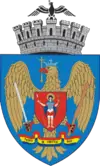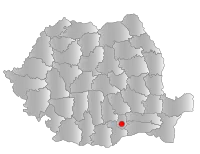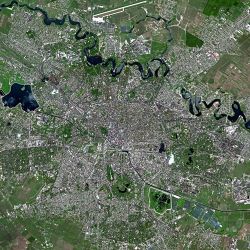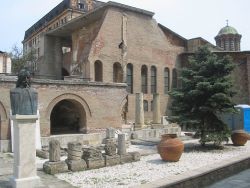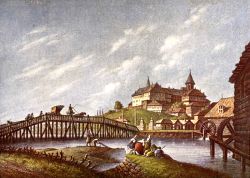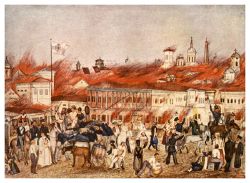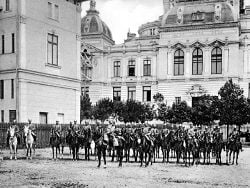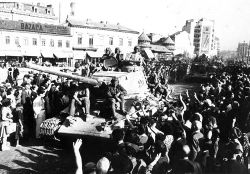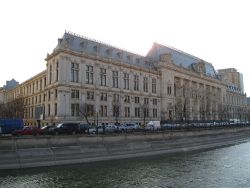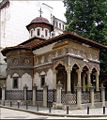Bucharest
| Bucharest Bucureşti |
|||
| The Palace of the Parliament | |||
|
|||
| Nickname: Little Paris, Paris of the East | |||
| Motto: Patria si Dreptul Meu (My Country and My Right) | |||
| Location of Bucharest within Romania (in red) | |||
| Coordinates: {{#invoke:Coordinates|coord}}{{#coordinates:44|25|57|N|26|6|14|E|type:city | |||
|---|---|---|---|
| name= }} | |||
| Country | Romania | ||
| County | Municipality of Bucharest | ||
| Founded | 1459 (first official record) | ||
| Government | |||
| - Mayor | Sorin Oprescu (Independent) | ||
| Area | |||
| - City | 228 km² (88 sq mi) | ||
| - Metro | 238 km² (91.9 sq mi) | ||
| Elevation | 60 - 90 m (197–295 ft) | ||
| Population (2007-July-11[1]) | |||
| - City | |||
| - Density | 8,510/km² (22,040.8/sq mi) | ||
| - Metro | 2,600,000 | ||
| Time zone | EET (UTC+2) | ||
| - Summer (DST) | EEST (UTC+3) | ||
| Postal Code | 0xxxxx | ||
| Area code(s) | +40 x1 | ||
| Car Plates | B | ||
| Website: www.pmb.ro | |||
Bucharest (Romanian: Bucureşti) is the capital city, as well as the economic, administrative, and cultural center of Romania. It is located in the southeast of the country, and lies on the banks of the Dâmboviţa River. Bucharest, which dates from 1459, became the state capital of Romania in 1862. Between the two World Wars, the city's elegant architecture and the sophistication of its elite earned Bucharest the nickname of the "Paris of the East" or "Little Paris" (Micul Paris).[2] Although many buildings and districts in the historic centre were damaged or destroyed by war, earthquakes, and by dictator Nicolae Ceauşescu's program of systematization, many survived.
Geography
The name of Bucur (from "bucurie" meaning "joy") is of Thracian-Geto-Dacian origin. In Albanian, a language which has historical connections with the Thracian languages, "bukur' signifies "beautiful".
Bucharest is situated in the south eastern corner of the Romanian Plain, in an area once covered by the Vlăsiei forest, which, after it was cleared, gave way to a fertile flatland. Bucharest is traditionally considered to have seven hills, in the tradition of the seven hills of Rome. Bucharest's seven hills are: Mihai Vodă, Dealul Mitropoliei, Radu Vodă, Cotroceni, Spirei, Văcăreşti and Sf. Gheorghe Nou.
The city has an area of 87 square miles (226 square kilometers). The altitude varies from 183.1 feet (55.8 meters) at the Dâmboviţa bridge in Căţelu, south-eastern Bucharest, and 300.2 feet (91.5 meters) at the Militari church. The city has a relatively round shape. Romania's Kilometre Zero is placed just south of University Square in front of the New St George Church.
Bucharest has a continental climate, characterised by hot, dry summers, and cold, windy winters, when temperatures often drop below freezing. Temperatures in January range from 21.2°F (-6°C) to 33.8°F (1°C), and in July from 60.8°F (16°C) to 82.4°F (28°C). Summer temperatures are usually pleasantly warm with occasional heat waves, and humidity is low, but there can be occasional rainstorms. The rainiest seasons are spring and autumn. Total mean annual rainfall is 23.5 inches (597mm).
Bucharest is situated on the banks of the Dâmboviţa River, which flows into the Argeş River, a tributary of the Danube. Several lakes – the most important of which are Lake Floreasca, Lake Tei and Lake Colentina – stretch across the city, along the Colentina River, a tributary of the Dâmboviţa. In the centre of the capital is a small artificial lake – Lake Cişmigiu – surrounded by the Cişmigiu Gardens.
History
During the Paleolithic era, small settlements existed in the thick forests of the location that became Bucharest. The Glina culture existed there during the Neolithic times, and the Gumelniţa culture included the region before the 19th century B.C.E. [3] During the Bronze Age, a third phase of the Glina culture (centered on pastoralism, partly superimposed on the Gumelniţa culture) and, later, the Tei culture evolved on Bucharest soil.[4]
In the Iron Age, the area was inhabited by the Getae and Dacians, who had commercial links with the Greek cities and the Romans. Bucharest was never under Roman rule, with an exception during Muntenia's brief conquest by the troops of Constantine I in the 330s C.E.
Slavs founded several settlements there, and the area was part of the First Bulgarian Empire between 681 and c.1000. The area was subject to the successive invasions of Pechenegs and Cumans and conquered by the Mongols during the 1241 invasion of Europe.
According to legend, the city was founded by a shepherd named Bucur (or, alternatively, a boyar of that same name). Its foundation has also been ascribed to the legendary 13th century Wallachian prince Radu Negru in stories first recorded in the 1500s.
First mentioned as "the Citadel of Bucureşti" in 1459, it became a residence of the Wallachian prince Vlad III the Impaler (1431-1476), known for his exceedingly cruel punishments, which included impaling people alive on stakes. The Old Princely Court (Curtea Veche) was built by Mircea Ciobanul, and during following rules, Bucharest was established as the summer residence of the court, competing with Târgovişte for the status of capital after an increase in the importance of southern Muntenia brought about by the demands of the Ottoman Empire.
Burned down by the Ottomans and briefly discarded by princes at the start of the 17th century, Bucharest was restored and continued to grow in size and prosperity. Its centre was around the street "Uliţa Mare", which starting 1589 was known as Lipscani. Before the 1700s, it became the most important trade centre of Wallachia and became a permanent location for the Wallachian court after 1698 (starting with the reign of Constantin Brâncoveanu (1689-1714)).
Partly destroyed by natural disasters and rebuilt several times during the following 200 years, hit by Caragea's plague in 1813-1814, the city was wrested from Ottoman control and occupied at several intervals by the Habsburg Monarchy (1716, 1737, 1789) and Imperial Russia (three times between 1768 and 1806).
It was placed under Russian administration between 1828 and the Crimean War, with an interlude during the Bucharest-centered 1848 Wallachian revolution, and an Austrian garrison took possession after the Russian departure (remaining in the city until March 1857). Additionally, on March 23, 1847, a fire consumed about 2000 buildings of Bucharest, destroying a third of the city. The social divide between rich and poor was described at the time by German socialist Ferdinand Lassalle (1825-1864) as making the city "a savage hotchpotch".
In 1861, when Wallachia and Moldavia were united to form the Principality of Romania, Bucharest became the new nation's capital; in 1881, it became the political center of the newly-proclaimed Kingdom of Romania. During the second half of the 19th century, due to its new status, the city's population increased dramatically, and a new period of urban development began. The extravagant architecture and cosmopolitan high culture of this period won Bucharest the nickname of "The Paris of the East", with Calea Victoriei as its Champs-Élysées or Fifth Avenue.
Between December 6, 1916, and November 1918, it was occupied by German forces, the legitimate capital being moved to Iaşi. After World War I, Bucharest became the capital of Greater Romania. As the capital of an Axis country, Bucharest suffered heavy losses during World War II, due to Allied bombings, and, on August 23, 1944, saw the the royal coup which brought Romania into the anti-German camp, suffering a short but destructive period of Luftwaffe bombings in reprisal. On November 8, 1945, the king's birthday, the Soviet-backed Petru Groza government suppressed pro-monarchist rallies.
During Nicolae Ceauşescu's leadership (1965-1989), most of the historic part of the city was destroyed and replaced with Communist-style buildings, particularly high-rise apartment blocks. The best example of this is Centrul Civic (the Civic Centre), including the Palace of the Parliament, where an entire historic quarter was razed to make way for Ceauşescu's megalomaniac constructions. In 1977, a strong (7.4 on the Richter-scale) earthquake claimed 1500 lives and destroyed many old buildings.
The Romanian Revolution of 1989 began with mass anti-Ceauşescu protests in Timişoara in December 1989 and continued in Bucharest, leading to the overthrow of the Communist regime. Dissatisfied with the post-revolutionary leadership of the National Salvation Front, student leagues and opposition groups organized large-scale protests continued in 1990 (the Golaniad), which were violently stopped by the miners of Valea Jiului (the Mineriad). Several other Mineriads followed, the results of which included a government change.
Government
Romania is a semi-presidential democratic republic where executive functions are shared between the president and the prime minister. The president is elected by popular vote for a term of five years. The bicameral parliament of Romania consists of the senate, which has 137 members, and the chamber of deputies, which has 332 members. The members of both chambers are elected every four years under a system of party-list proportional representation.
Bucharest has a unique status in Romanian administration, since it is the only municipality that is not part of a county.
The city government is headed by a general mayor. The general council is made up of 55 elected councillors. The city is divided into six administrative sectors (sectoare), each of which has their own 27-seat council, town hall and mayor. The main city hall is responsible for the water system, transport, and the main boulevards. Sectorial town halls manage the contact between individuals and the local government, secondary streets, parks, schools and cleaning services.
The six sectors are numbered from one to six and are disposed radially so that each one has under its administration an area of the city center. They are numbered clockwise and are further divided into districts.
Bucharest's sectorial councils, the general council, and the mayors, are elected every four years by popular vote. Additionally, Bucharest has a prefect, who is appointed by central government, who is not allowed to be a member of a political party, and whose role is to represent the national government at local level.
The Municipality of Bucharest, along with the surrounding Ilfov county, forms the Bucharest development region, which is equivalent to NUTS-II regions in the European Union and is used by the European Union and the Romanian Government for statistical analysis and regional development.
Each of the six sectors has their own local tribunal, while appeals from these tribunals' verdicts, and more serious cases, are directed to the Bucharest Court of Appeals, the city's municipal court. Bucharest is home to Romania's supreme court, the High Court of Cassation and Justice, as well as other national courts such as the Constitutional Court of Romania and the National Military Tribunal.
Bucharest has its own municipal police force. Bucharest's crime rate is rather low in comparison to other East-European capital cities. Petty crime, however, is more common, particularly in the form of pickpocketing, which occurs on the city's public transport network. A significant problem in the city remains institutional corruption, which is seen as the most important justice-and-law related problem in the city.
Economy
Romania has a large, upper-middle-income economy, the 15th largest in Europe based on purchasing power parity. Bucharest is the most economically-developed and industrialised city in Romania, producing around 21 percent of the country's gross domestic product and about one-quarter of its industrial production, while only accounting for nine percent of the country's population. Almost one third of national taxes is paid by Bucharest's citizens and companies. In 2005, at purchasing power parity, Bucharest had a per-capita GDP of $US25,210, or 74.8 percent that of the European Union average and more than twice the Romanian average.
The city's strong economic growth has revitalised infrastructure and led to the development of many shopping malls and modern residential towers and high-rise office buildings. In September 2005, Bucharest had an unemployment rate of 2.6 percent, significantly lower than the national unemployment rate of 5.7 percent.
Bucharest's economy is mainly centred on industry and services, with services particularly growing in importance in the last 10 years. The city serves as the headquarters of 186,000 firms, including nearly all large Romanian companies.
An important source for growth since 2000 has been the city's property and construction boom. Bucharest is also Romania's largest centre for information technology and communications and is home to several software companies operating offshore delivery centers. Bucharest contains Romania's largest stock exchange, the Bucharest Stock Exchange, which was merged in December 2005 with the Bucharest-based electronic stock exchange, Rasdaq.
The city has a number of international supermarket chains such as Carrefour, Cora and METRO. In 2008, the city was undergoing a retail boom, with a large number of supermarkets, and hypermarkets, constructed every year. There are also a large number of traditional markets; the one at Obor covers about a dozen city blocks, and numerous large stores.
Bucharest is the most important centre for Romanian mass media, since it is the headquarters of all the national television networks as well as national newspapers and radio stations.
In Bucharest the average salary is $US1918 a month which is higher than that of Spain. Also as Romania is experiencing a real construction boom the average price for a central one bedroom flat is around $US1246 which puts the price of rent on par with Paris.
Bucharest's extensive public transport system is made up of the Bucharest Metro, as well as a surface transport system run by RATB (Regia Autonomă de Transport Bucureşti), which consists of buses, trams, trolleybuses and light rail. In addition, there is a private minibus system. Bucharest is the hub of Romania's national railway network. Bucharest is also a major intersection of Romania's national road network.
The city is served by two airports. Henri Coandă International Airport is the largest airport in Romania with five million passengers in 2007 and the main hub for the national operator TAROM. The smaller Aurel Vlaicu International Airport is used for charter flights and low-cost carriers.
Although it is situated on the banks of a river, Bucharest has never functioned as a port city, with other Romanian cities such as Constanţa and Brăila acting as the country's main ports. However, the Danube-Bucharest Canal, which is 45 miles (73km) long, was under construction in 2008, will link Bucharest to the Danube River and, via the Danube-Black Sea Canal, to the Black Sea.
Demographics
| Historical population of Bucharest | |||||||||||||
| Year | Population | ||||||||||||
|---|---|---|---|---|---|---|---|---|---|---|---|---|---|
| 1789 | 30,030 | ||||||||||||
| 1831 | |||||||||||||
| 1859 | |||||||||||||
| 1900 | |||||||||||||
| 1918 | |||||||||||||
| 1930 | |||||||||||||
| January 25, 1948 census | |||||||||||||
| February 21, 1956 census | |||||||||||||
| March 15, 1966 census | |||||||||||||
| January 5, 1977 census | |||||||||||||
| July 1, 1990 estimate | |||||||||||||
| January 7, 1992 census | |||||||||||||
| March 18, 2002 census | |||||||||||||
| July 1, 2005 estimate | |||||||||||||
| January 1, 2006 estimate | |||||||||||||
| July 11, 2007 estimate | |||||||||||||
Bucharest proper had a population of 1,931,838, according to 2007 official estimates. Adding the satellite towns around the urban area, the metropolitan area of Bucharest had a population of 2.6 million people. Bucharest is the sixth largest city in the European Union by population within city limits.[6]
Bucharest's population experienced two phases of rapid growth, the first in the late 19th century, and the second during the Communist period, when a massive urbanisation campaign was launched and many people migrated from rural areas. Ceauşescu's ban on abortion and contraception, natural increase was also significant.
Approximately 97 percent of the population of Bucharest are ethnic Romanians, with the second largest ethnic group being the Roma, which make up 1.4 percent of the population. Other significant ethnic groups are Hungarians (0.3 percent), Jews (0.1 percent), Turks (0,1 percent) and Germans (0,1 percent). Some other inhabitants of Bucharest are of Greek, Armenian, Lipovan and Italian descent. A native or resident of Bucharest is called Bucharester.
The official language is Romanian, an Eastern Romance language. English and French are the main foreign languages taught in schools.
In terms of religion, 96.1 percent of the population are Romanian Orthodox, 1.2 percent are Roman Catholic, 0.5 percent are Muslim and 0.4 percent are Eastern Rite-Catholic. Despite this, only 24 percent of the population, of any religion, attend a place of worship once a week or more.[8]
As the most developed city in Romania, Bucharest has a broad range of educational facilities.
Of interest
Bucharest has a number of landmark buildings and monuments. Bucharest's architecture is highly eclectic. The city centre is a mixture of medieval, neoclassical and art nouveau buildings, as well as “neo-Romanian” buildings dating from the beginning of the 20th century and a remarkable collection of modern buildings from the 30s and 40s. A French influence on buildings meant Bucharest was once called "the Paris of the East" or "Little Paris." Very present as well the mostly-utilitarian Communist-era architecture. The city is lately invaded by contemporary structures such as skyscrapers and office buildings, mainly constructed after 2000.
- The Palace of the Parliament, built in the 1980s during the reign of Communist dictator Nicolae Ceauşescu, is the largest building in Europe and the second-largest in the world. It houses the Romanian Parliament (the Chamber of Deputies and the Senate), as well as the National Museum of Contemporary Art. It is also often used as a convention centre.
- Another well-known landmark of Bucharest is Arcul de Triumf (The Triumphal Arch), built in 1935 and modeled after the Arc de Triomphe in Paris.
- The Memorial of Rebirth is a stylized marble pillar unveiled in 2005 to commemorate the victims of the Romanian Revolution of 1989, which overthrew Communism.
- The Romanian Athenaeum building is considered to be a symbol of Romanian culture and since 2007 is on the list of the Label of European Heritage sights.
- Other cultural venues include the National Museum of Art, Museum of Natural History "Grigore Antipa", Museum of the Romanian Peasant (Muzeul Ţăranului Român), National History Museum, and the Military Museum.
In terms of visual arts, the city contains a number of museums featuring both classical and contemporary Romanian art, as well as selected international works.
- The National Museum of Art of Romania features extensive collections of medieval and modern Romanian art, including works by renowned sculptor Constantin Brâncuşi.
- The Zambaccian Museum contains works by many well-known Romanian artists as well as international artists such as Paul Cézanne, Eugène Delacroix, Henri Matisse, Camille Pissarro and Pablo Picasso.
- The Gheorghe Tattarescu Museum contains portraits of Romanian revolutionaries in exile such as Gheorghe Magheru, Ştefan Golescu, Nicolae Bălcescu and allegorical compositions with revolutionary (Romania's rebirth, 1849) and patriotic (The Principalities' Unification, 1857) themes.
Bucharest is the location of the neoclassical Romanian Athenaeum, founded in 1852, which hosts classical music concerts, the George Enescu Festival, and is home to the "George Enescu" Philharmonic. Bucharest is also home to the Romanian National Opera, as well as the I.L. Caragiale National Theatre. Another well-known theatre in Bucharest is the State Jewish Theatre..
Bucharest is home to Romania's largest recording labels. Many Romanian rock bands of the 1970s and 1980s, such as Iris and Holograf, continue to be popular, while since the 1990s there has been growth in the boy band and hip hop genres. The eclectic pop-rock band Taxi have been gaining international respect, as has Spitalul de Urgenţă's raucous updating of traditional Romanian music. While many discos play manele, a Turkish-influenced type of music that is particularly popular in Bucharest's working class districts, the city has an increasing jazz and blues scene, and, to an extent, eurodance/trance and heavy metal/punk.
The city's nightlife, particularly its club scene grew significantly in the 1990s. The city does not have a central nightlife strip, with many entertainment venues dispersed throughout the city centre, with a cluster in the historical centre. One of the city's best known clubs is the Lăptăria Enache and the La Motoare, located above (on the rooftop of) the National Theatre, as well as [citation needed] Fire Club and Club A. The city also hosts some acclaimed electronic/house music clubs such as Bamboo and Krystal Club.
Bucharest has two internationally-renowned ethnographic museums, the Museum of the Romanian Peasant and the open-air Village Museum, in Herăstrău Park, which contains 272 authentic buildings and peasant farms from all over Romania. The Museum of Romanian History contains a collection of artefacts detailing Romanian history and culture from the prehistoric times, Dacian era, medieval times and the modern era.
The National Opera organises the International Opera Festival every year in May and June. The Romanian Athaeneum Society hosts the George Enescu Classical Music Festival at various locations throughout the city in September every year. Additionally, the Museum of the Romanian Peasant and the Village Museum organise a number of events throughout the year showcasing Romanian folk arts and crafts.
In 2005, Bucharest was the first city in Southeastern Europe to host the international CowParade, which resulted in dozens of decorated cow sculptures being placed at various points across the city. Since 2005 Bucharest has its own contemporary art biennale, the Bucharest Biennale.
The 2000s also saw an increasing visibility of Bucharest gay culture, with the opening of the Queen's Club, the first LGBT club in the city, in 2001, and the launch of the annual Bucharest GayFest in 2004. The city's first gay pride parade was held as part of the 2005 GayFest.
Gallery
- The University of Bucharest Library.jpg
The University of Bucharest Library
George Enescu Museum - The Cantacuzino Palace
- Cotroceni Palace Bucharest.jpg
The Cotroceni Palace
- Elegant Fountains.jpg
In Front of the Palace of the Parliament
- Modern architecture Bucharest.jpg
Modern architecture on the banks of Dâmboviţa River
- Bancorex building bgiu.jpg
Bucharest Financial Plaza Tower
- Herastrau Park.jpg
Herăstrău Park
- Nicolae Balcesco Boulevard by night.jpg
Nicolae Balcesco Boulevard by night
- Cismigiu Gardens.jpg
The Cişmigiu Gardens
- Old Bucharest.jpg
The old city center of Bucharest
- Stravopoleos street.jpg
Stavropoleos street, with the CEC Palace in the background
- Ion Heliade Radulescu.jpg
Statue of Ion Heliade Rădulescu in University Square
- Bucharest The Palace of the Parliament.jpg
The Palace of the Parliament from above
- Revolution Square Bucharest.jpg
Statue of Iuliu Maniu in Revolution Square
- Howard Johnson Hotel Bucharest.jpg
Howard Johnson Hotel
- Hotel Intercontinental Boekarest.jpg
InterContinental Hotel
- Rosetti1.jpg
Millennium Business Center
- BUCmuzeultaranului2.jpg
Museum of the Romanian Peasant
- Hanul Manuc Courtyard 4.jpg
Manuc's Inn
- Opera2Bucuresti.JPG
Romanian National Opera
- Casa Scanteii.jpg
The House of the Free Press
- Cladirea ASE Bucuresti.jpg
Bucharest Academy of Economic Studies
- Politehnica rectorat.jpg
Polytechnic University of Bucharest
Notes
- ↑ Population of Romania as of July 11, 2007
- ↑ Bucharest, the small Paris of the East, on the Museums from Romania web site.
- ↑ Giurescu, p.25-26; Morintz and Rosetti, p.12-18
- ↑ Giurescu, p.26; Morintz and Rosetti, p.18-27
- ↑ 5.0 5.1 5.2 5.3 5.4 5.5 (English) INS, Government of Romania. "Population at the 1948, 1956, 1966, 1977, 1992 and 2002 censuses by municipalities and towns" (PDF). Retrieved 2007-03-07.
- ↑ 6.0 6.1 6.2 6.3 (Romanian) INS, Government of Romania. "Populaţia, pe sexe şi medii, la 1 iulie". Retrieved 2007-03-07. Cite error: Invalid
<ref>tag; name "bucharest_pop_estimates" defined multiple times with different content - ↑ http://www.insse.ro/RPL2002INS/vol5/tables/t02.pdf
- ↑ Open Society Institute's Survey into Religiosity in Romania (Microsoft Word document)
ReferencesISBN links support NWE through referral fees
- Webcam Live in Bucharest
- Modern history of Bucharest, City Hall of Bucharest
- Public transport in Bucharest, InYourPocket Bucharest, 2005
- Şerban Cantacuzino, Două Oraşe Distincte. Revista Secolul XX 4/6 (1997): 11–40
- Ernie Schoffham, Luminiţa MacHedon, Şerban Cantacuzino, Romanian Modernism: The Architecture of Bucharest, 1920-1940
- Romania: Arts & Architecture, Romanian Tourist Office
- Tatiana Murzin, Romanian Education, 2005
- Romanian Education Portal, Site for the Ministry of Education containing lists of all educational establishments.
- Overview of Bucharest, Fodor's Travel Guide
- Bucharest, the small Paris of the East, on the Museums from Romania web site.
- Bucica, Cristina.
 PDF, 2000.
PDF, 2000.
External links
Official sites
- Bucharest: Official administration site
- The Bucharest Prefecture
- RATB (Public Transport Company) official website
- Metrorex (Underground Transport Company) official website
- Bucharest Airport Henri Coanda
- Bucharest Airport Aurel Vlaicu
- (National Railway Company) official website
- (Railway Passenger Transport) official website
- (Romania Bus Passenger) official website
- City of Bucharest
City guides
- Travel guide to Bucharest from Wikitravel
- Bucharest Interactive map
Other
- Bucharest between the World Wars: A modernity with fringes, exhibition by the Centre of Excellence in Image Studies (CESI), of the University of Bucharest.
- Bucureştii - un oraş fară istorie ... ??!! / Bucurestiul - inainte de ... ("Bucharest - a city without history ... ??!! / Bucharest - before ..."). Extensive collection of historical photos and drawings.
- Article on Building in Bucharest: The city where anything goes, From 'The Diplomat - Bucharest' magazine
- A red's white elephant 2005 National Review article by Anthony Daniels
- [1] Views from Bucharest
- Bucharest trolleybus
Credits
New World Encyclopedia writers and editors rewrote and completed the Wikipedia article in accordance with New World Encyclopedia standards. This article abides by terms of the Creative Commons CC-by-sa 3.0 License (CC-by-sa), which may be used and disseminated with proper attribution. Credit is due under the terms of this license that can reference both the New World Encyclopedia contributors and the selfless volunteer contributors of the Wikimedia Foundation. To cite this article click here for a list of acceptable citing formats.The history of earlier contributions by wikipedians is accessible to researchers here:
The history of this article since it was imported to New World Encyclopedia:
Note: Some restrictions may apply to use of individual images which are separately licensed.

